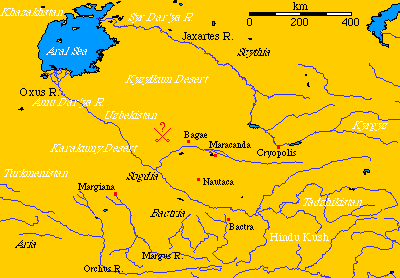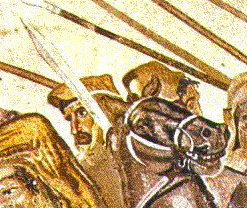


The battle probably involved not much over 10000 men in total, so is one of the few Hellenistic actions suitable for a small-scale DBM refight. The exact location of the battle is unknown, other than it was near a fortified stronghold in Sogdia called Gabai, near the border with the Massagetic Skythians. It took place in late 328 BC, probably in late autumn or early winter, near the western parts of the desert region now known as the Karakumy.
|
Alexander had over-run Sogdia in 329 BC, but subsequently withdrawn, and the area had to be reconquered again the following year, as Spitamenes, a local leader, had waged a very successful campaign against the inadequate garrison forces Alexander had left behind, aided by Skythians from across the Oxus river (there is some evidence that the Oxus used to flow east in Alexander's time into the Caspian sea, rather than north into the Aral). During the year 328 BC, Alexander established a network of fortified points to tie down the area, and according to Arrian, Spitamenes, seeing no prospects of overcoming these using his old guerilla strategy, decided to risk a pitched battle with Coenus' forces.
Unfortunately for the resistance movement, Coenus' men triumphed, losing about 40 men in the process, while killing 800 of the enemy. At this, Spitamenes' remaining Sogdian troops, as well as most of his Bactrians surrendered, while he himself escaped with the Skythians, plundering the baggage train as they went. When the Skythians heard Alexander was himself in pursuit, they cut off Spitamenes' head and sent it to him to avoid retribution for their involvement in the war.
|

|
Coenus' winter camp was at Marakanda (Samarkand, Arrian, 4.16.3 and 4.17.3; Quintus Curtius 8.2.14), and so the battle was presumably someplace to its west. His force amounted to two taxeis of Macedonian pezetoiroi, his own and Meleager's, about 400 Companion cavalry, all the hippakontistai, and the Bactrians and Sogdians attached to Amyntas (Arrian 4.17.3).
Each pezetairoi taxeis numbered 2000 men (see my Macedonian numbers and unit organisations for this), and the 400 Companions probably represent a single understrangth hipparchy (nominal strength 512 men, see the above notes), since we know that small numbers of Companions were scattered around the province in charge of the garrisoned strongholds (e.g. Arrian 4.16.6).
The hippakontistai, or horsed javelinmen, recruited from Asiatics such as Paphlogonians, had by 330 BC grown to the size of a taxis (Arrian 3.24.1), but we are not told the strength of a taxis when it refers to horsemen. The Prodromoi, or Macedonian light horse, were at that stage still organised in four ilai, nominally 256 men strong, and as it seems they were absorbed into the Companons, with their role being taken by the akontistai, it is likely that the akontistai were at least as strong, if not more so. Since, unlike the Greek mercenaries (Arrian 4.4.6), they were seemingly not organised into hipparchies, perhaps they were 1000 strong (later they could be split in half, Arrian 4.24.1, so maybe they comprised two hipparchies).
The Bactrians and Sogdians 'attached to Amyntas' are enigmatic. Since the horsemen the nearby Skythian Chorasmian king Pharasmenes had offered previously to Alexander were noted as being 1500 strong (Arrian 4.15.3), the number of Amyntas' men was presumably smaller; probably much smaller since Bactria and Sogdia were not yet pacified. I will make a guess at 500 all-told. Amyntas son of Andromenes, the phalanx taxiarch, had been killed recently (Arrian 3.27.3), so the Amyntas who soon would be left in charge of the large garrison of Bactria is no doubt meant (Arrian 4.22.3). This may be the Amyntas son of Arrabaeus who had previously (but not recently) commanded the Macedonian Prodromoi horsemen (Arrian 1.14.1).
The Macedonians then, at the normal scale of 250 men per element, can be represented as:
2 x Reg Kn (F) - the Companions
8 x Reg Pk (O) - Coenus' battalion
8 x Reg Pk (O) - Meleagers' battalion
4 x Irr LH (O) - the Hippakontistai
1 x Irr Cv (O) - the Bactrians
1 x Irr LH (F) - the Sogdians
2 x Irr Bg (I) - the baggage train (mobile)
One element, of either Kn (F) or Pk (O), represents Coenus, and counts as the CinC. The force is too small to warrant the inclusion of Meleager or Amyntas as a sub-general. The Macedonians total 137 AP, and break on 8.
Spitamene's forces were seemingly all mounted (4.17.5). In addition to his own Sogdians and Bactrians, he had pursuaded 3000 Massagetic Skythians to join him (Arrian 3.17.4). The numbers of Sogdians and Bactrians is unknown, but likely to be relatively small, only a short time before, a Macedonian force ofabout 100 cavalry had rashly attacked them as they were scattered about plundering, even though they were augmented by 600 Skythians at the time.
I will estimate his forces as the following:
1 x Irr Cv (O) - Spitamenes and his Sogdian followers
3 x Irr Cv (I) - Sogdian colonist cavalry
3 x Irr LH (F) - local Sogdians
3 x Irr Cv (O) - Bactrians
4 x Irr Bg (I) - the baggage train (mobile)
3 x Irr Cv (S) - Massagetic nobles
9 x Irr LH (F) - other Massagetic tribesmen
Spitamenese counts as a sub-general (so does not get a CinC's PiP bonus); one of the Massagetic noble elements should also count as an ally-general. The Massagetae break on 4, the Sogdians on 4; the whole force breaks on 8 and amounts to 126 AP. The Messagetae can be unreliable, since Arrian states they joined to raid Sogdia, when it appears Spitamenes' intent was to instead force battle - they may not have been too happy to see Coenus' force!
I have classified most of the Sogdians as colonist horse rather than nomads since Arrian refers to the 'line of battle' (4.17.4) which wouldn't be much of a line if virtually all the forces were light horse archers (as was the case with his Skythians, cf. Arrian 4.5.4)

Fighting the battle:
Play the action on a reduced-sized table: I suggest 4' by 3', or 1200 by 900 mm, in 15mm scale, with the short edges facing north and south. The Macedonians should face west, the Sogdians east; the Massagetae may not flank march. The time of day should be determined in the normal manner, rerolling any result that calls for a battle at night; the weather should be determined normally (the climate is Dry, the season winter) except that a result of rain will instead produce snow (it snowed a lot much later in the winter, Arrian 4.21.10).
The battlefield should be depicted as dry steppe. Spitamenes had proved himself a master of small-action warfare: according Aristobolus, he had previously cut up a Macedonian column of over 2300 troops of Alexander's led by Pharnuces by ambushing them from a large park (or paradise) so effectively that barely 300 escaped (Arrian 4.6.1), so that some scope for ambush positions should be allowed. The Macededonians count as the invader, the defender's terrain list should be limited to Rd (only one allowed, and only if positioned by the invader), RGo, O (like the above paradise) and gentle hills (that may have RGo on them). The Sogdians must position 1 or 1.5 quivalents of features, the Macedonians, if they decide not to invade down a road, may position in the 3rd terrain-positioning phase just one 0.5 equivalent feature, due to the small size of the battlefield.
Special rules:
The odds of straight military victory are with the Macdonians, however, being essentially guerilla fighters, just driving the Sogdians will not be enough to win the campaign outright; they will just come back again, as before. Accordingly, to gain a complete victory, the Macedonians must not only break the enemy without being broken, but also destroy Spitamenes' element or have at least 4 elements of mounted troops left (or they won't be able to pursue the defeated enemy to make them surrender). The Macedonians gain only a marginal victory if they otherwise break the enemy without being broken themselves.
The Sogdians gain a complete victory if they break the Macedonians without breaking themselves. Long live the rebellion! They gain a marginal victory if they destroy at least 4 Macedonian mounted elements, and withdraw off the table without having either command broken, or if they either destroy both Macedonian Bg elements (or the Macedonian player moves them off table voluntarily) without having either of their own commands broken (the plunder will help the rebellion along)
Any other result is a draw.
References:
Arrian's Anabasis of Alexander, Loeb edition of 1976, translated by P.A. Brunt
Quintus Curtius' History of Alexander, Penguin edition
An excellent overveiw of Alexander's operations in Bactria can be found in Peter Hall's "At the Ends of Empire - Alexander's Bactrian War" in Slinghot issue 210, pages 12-15.
